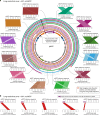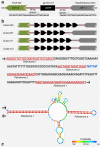The Wolbachia mobilome in Culex pipiens includes a putative plasmid
- PMID: 30837458
- PMCID: PMC6401122
- DOI: 10.1038/s41467-019-08973-w
The Wolbachia mobilome in Culex pipiens includes a putative plasmid
Erratum in
-
Author Correction: The Wolbachia mobilome in Culex pipiens includes a putative plasmid.Nat Commun. 2019 Jul 12;10(1):3153. doi: 10.1038/s41467-019-11234-5. Nat Commun. 2019. PMID: 31300646 Free PMC article.
Abstract
Wolbachia is a genus of obligate intracellular bacteria found in nematodes and arthropods worldwide, including insect vectors that transmit dengue, West Nile, and Zika viruses. Wolbachia's unique ability to alter host reproductive behavior through its temperate bacteriophage WO has enabled the development of new vector control strategies. However, our understanding of Wolbachia's mobilome beyond its bacteriophages is incomplete. Here, we reconstruct near-complete Wolbachia genomes from individual ovary metagenomes of four wild Culex pipiens mosquitoes captured in France. In addition to viral genes missing from the Wolbachia reference genome, we identify a putative plasmid (pWCP), consisting of a 9.23-kbp circular element with 14 genes. We validate its presence in additional Culex pipiens mosquitoes using PCR, long-read sequencing, and screening of existing metagenomes. The discovery of this previously unrecognized extrachromosomal element opens additional possibilities for genetic manipulation of Wolbachia.
Conflict of interest statement
The authors declare no competing interests.
Figures




Similar articles
-
Living in the endosymbiotic world of Wolbachia: A centennial review.Cell Host Microbe. 2021 Jun 9;29(6):879-893. doi: 10.1016/j.chom.2021.03.006. Epub 2021 May 3. Cell Host Microbe. 2021. PMID: 33945798 Free PMC article. Review.
-
Wolbachia and its pWCP plasmid show differential dynamics during the development of Culex mosquitoes.Microbiol Spectr. 2025 Mar 31;13(5):e0004625. doi: 10.1128/spectrum.00046-25. Online ahead of print. Microbiol Spectr. 2025. PMID: 40162749 Free PMC article.
-
Lack of abundant core virome in Culex mosquitoes from a temperate climate region despite a mosquito species-specific virome.mSystems. 2024 Jun 18;9(6):e0001224. doi: 10.1128/msystems.00012-24. Epub 2024 May 14. mSystems. 2024. PMID: 38742876 Free PMC article.
-
WO bacteriophage transcription in Wolbachia-infected Culex pipiens.Insect Biochem Mol Biol. 2006 Jan;36(1):80-5. doi: 10.1016/j.ibmb.2005.11.001. Insect Biochem Mol Biol. 2006. PMID: 16360953
-
Phage WO of Wolbachia: lambda of the endosymbiont world.Trends Microbiol. 2010 Apr;18(4):173-81. doi: 10.1016/j.tim.2009.12.011. Epub 2010 Jan 18. Trends Microbiol. 2010. PMID: 20083406 Free PMC article. Review.
Cited by
-
Accurate and complete genomes from metagenomes.Genome Res. 2020 Mar;30(3):315-333. doi: 10.1101/gr.258640.119. Epub 2020 Mar 18. Genome Res. 2020. PMID: 32188701 Free PMC article. Review.
-
Diversity and function of arthropod endosymbiont toxins.Trends Microbiol. 2022 Feb;30(2):185-198. doi: 10.1016/j.tim.2021.06.008. Epub 2021 Jul 9. Trends Microbiol. 2022. PMID: 34253453 Free PMC article. Review.
-
Ecological Divergence Within the Enterobacterial Genus Sodalis: From Insect Symbionts to Inhabitants of Decomposing Deadwood.Front Microbiol. 2021 Jun 11;12:668644. doi: 10.3389/fmicb.2021.668644. eCollection 2021. Front Microbiol. 2021. PMID: 34177846 Free PMC article.
-
Highly Sensitive Virome Characterization of Aedes aegypti and Culex pipiens Complex from Central Europe and the Caribbean Reveals Potential for Interspecies Viral Transmission.Pathogens. 2020 Aug 21;9(9):686. doi: 10.3390/pathogens9090686. Pathogens. 2020. PMID: 32839419 Free PMC article.
-
Living in the endosymbiotic world of Wolbachia: A centennial review.Cell Host Microbe. 2021 Jun 9;29(6):879-893. doi: 10.1016/j.chom.2021.03.006. Epub 2021 May 3. Cell Host Microbe. 2021. PMID: 33945798 Free PMC article. Review.
References
-
- Shragai T, Tesla B, Murdock C, Harrington LC. Zika and chikungunya: mosquito-borne viruses in a changing world. Ann. NY Acad. Sci. 2017;1399:61–77. - PubMed
-
- Boyer S, Calvez E, Chouin-Carneiro T, Diallo D, Failloux AB. An overview of mosquito vectors of Zika virus. Microbes Infect. 2018;20:646–660. - PubMed
Publication types
MeSH terms
Grants and funding
LinkOut - more resources
Full Text Sources
Other Literature Sources

